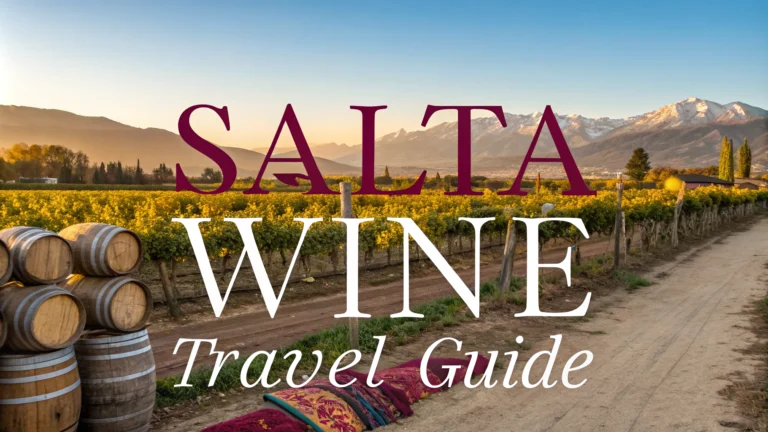Salta: A Unique Wine Region in Northern Argentina
Salta, nestled in northwestern Argentina, offers a high-altitude wine experience unlike any other. Its vineyards, some of the highest in the world, produce distinctive wines with intense flavors and aromas.
Towns and Villages
Salta City serves as the region’s capital and main hub for wine tourism. Cafayate, located in the Calchaquí Valleys, is the heart of Salta’s wine country.
- Salta City: Colonial architecture, museums, and a starting point for wine tours
- Cafayate: Surrounded by vineyards, offering wine tasting and scenic views
- Cachi: A charming town with pre-Columbian ruins and boutique wineries
Wine Producers
Salta boasts several renowned wineries, each offering unique experiences. Some standout producers include:
- Bodega Colomé: Argentina’s oldest working winery, known for high-altitude Malbec
- Piattelli Vineyards: Modern winery with stunning views and a range of varietals
- El Porvenir de Cafayate: Family-run winery specializing in Torrontés and Tannat
- Bodega El Esteco: Historic winery with a luxury wine resort
Accommodations
Salta offers a range of accommodations, from luxury wine resorts to cozy bed and breakfasts. Consider these options:
- Grace Cafayate: Luxury resort with its own vineyard and golf course
- Patios de Cafayate: Wine hotel nestled among vineyards
- Finca Valentina: Charming country house near Salta City
- Hotel Legado Mítico Salta: Boutique hotel in Salta City’s historic center
Dining
Salta’s cuisine blends Andean and Spanish influences, perfectly complementing its wines. Don’t miss these dining experiences:
- Casa de Molino (Cafayate): Traditional Argentine cuisine with vineyard views
- Patio de la Empanada (Salta City): Sample local empanadas from various vendors
- Restaurante Terruño (Cafayate): Fine dining with a focus on local ingredients and wines
- La Casona del Molino (Salta City): Traditional peña featuring live folk music and local dishes
Wine Shops & Bars
Salta offers unique venues to taste and purchase local wines. Visit these spots for an authentic experience:
- Vinoteca La Bodega (Salta City): Extensive selection of regional wines
- El Almacén de Ramos Generales (Cafayate): Wine shop with local specialties
- Bad Brothers Wine Experience (Cafayate): Modern wine bar with tapas
- Chato’s Wine Bar (Salta City): Cozy bar offering wine flights and small plates
Other Shops
Explore local crafts and products in these shops:
- Mercado Artesanal (Salta City): Traditional textiles, pottery, and souvenirs
- Puna Andes (Cafayate): High-quality alpaca wool products
- Feria Artesanal (Cafayate): Open-air market with local handicrafts
Attractions
Beyond wine, Salta offers diverse attractions:
- MAAM Museum (Salta City): Houses the famous Incan mummies
- Quebrada de las Conchas: Stunning rock formations and landscapes
- San Bernardo Cable Car (Salta City): Panoramic views of the city
- Quilmes Ruins: Ancient indigenous fortress near Cafayate
Events
Time your visit with these wine-focused events:
- Torrontés Festival (February, Cafayate): Celebrates Salta’s signature white grape
- Salta Wine Tour (April): Wine tastings and cultural events across the region
- Cafayate Serenata (February): Music festival with local wine tastings
Appellations
Salta’s wine regions are part of the larger Northwestern Argentina appellation. Key sub-regions include:
- Calchaquí Valleys: Home to some of the world’s highest vineyards
- Cafayate: Renowned for Torrontés and high-altitude Malbec
- Molinos: Extreme high-altitude vineyards producing unique wines
Grape Varieties
Salta’s high-altitude vineyards produce exceptional wines from several grape varieties. Torrontés reigns supreme as the region’s signature white grape.
Other notable varieties include:
- Malbec
- Cabernet Sauvignon
- Tannat
- Syrah
- Chardonnay
Main Wine Styles
Salta’s wines are known for their intense flavors and aromas, a result of the region’s high-altitude vineyards. The main styles include:
- Aromatic and floral Torrontés whites
- Bold and fruity Malbecs
- Full-bodied Cabernet Sauvignons
- Robust Tannats
Food Specialties
Salta’s cuisine blends Andean and Spanish influences. Local specialties pair beautifully with the region’s wines:
- Locro: A hearty stew perfect with Malbec
- Empanadas Salteñas: Savory pastries that complement Torrontés
- Tamales: Corn-based dish ideal with Cabernet Sauvignon
- Humitas: Corn and cheese delicacy great with Chardonnay
Drives & Walks
Explore Salta’s stunning landscapes and vineyards through scenic drives and walks:
Drives
- Cafayate Wine Route: A 189 km journey through the Calchaquí Valleys
- Cachi Road: A picturesque drive through the Andes to wine country
Walks
- San Lorenzo: Hike through lush forests near Salta city
- Quebrada de las Conchas: Explore dramatic rock formations near Cafayate
Itineraries
Plan your Salta wine adventure with these suggested itineraries:
3-Day Wine Tour
- Day 1: Explore Salta city, visit local wine bars
- Day 2: Drive to Cafayate, tour wineries, enjoy a wine pairing dinner
- Day 3: Visit more Cafayate wineries, return to Salta via Quebrada de las Conchas
7-Day Salta Wine and Culture Experience
- Days 1-2: Salta city exploration and nearby wineries
- Days 3-4: Cafayate wine region
- Day 5: Cachi and its boutique wineries
- Days 6-7: Return to Salta, visit museums and enjoy final wine tastings
Getting There & Around
Reach Salta via Martín Miguel de Güemes International Airport, with connections from Buenos Aires. Within the region:
- Rental cars: Best for exploring vineyards independently
- Public buses: Connect major towns, but less convenient for winery visits
- Guided tours: Ideal for hassle-free winery hopping
Best Time to Visit
Salta’s wine region offers year-round appeal, but consider these factors:
- March to May: Harvest season, perfect for winery tours
- September to November: Spring brings mild temperatures and blooming landscapes
- June to August: Cooler temperatures, ideal for red wine tastings
Sustainability Efforts
Salta’s wine industry is increasingly focusing on sustainable practices:
- Organic vineyards: Many producers are transitioning to organic farming
- Water conservation: Drip irrigation systems help preserve this precious resource
- Solar power: Some wineries utilize solar energy for operations
Language Tips
Spanish is the primary language in Salta. Key wine-related phrases:
- “Una degustación, por favor” – A tasting, please
- “¿Cuál es su vino más popular?” – What’s your most popular wine?
- “Salud!” – Cheers!
Further Resources
Enhance your Salta wine experience with these resources:

